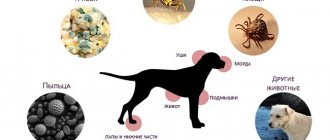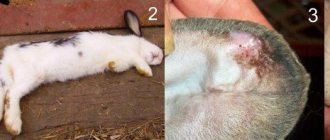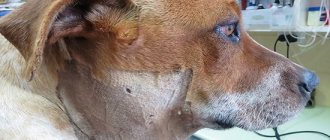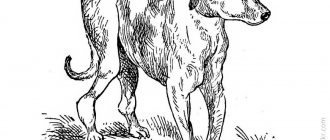Prevention measures
At home, prevention involves following basic precautions. Traditionally, distemper is transmitted from animal to animal by airborne droplets, but there are other methods of infection. Your pet can “catch” the disease from the following sources:
- dirty water;
- poor quality food;
- urine;
- fecal discharge (for example, during sniffing);
- hygiene items for other dogs (combs, washcloths, bowls).
Experts also note that in addition to a dog, a wild animal can also infect your pet with plague. Among the main carriers, the most common are fox, wolf, arctic fox, and mink.
To prevent infection from occurring, monitor the quality of the animal’s diet and also keep the premises in order. Especially if you have several dogs living in your house. Do not allow personal items of a sick animal to be used in caring for a healthy one.
While walking, keep an eye on who your pet comes in contact with. Do not allow your dog to be bitten by strange dogs or fights in general. Animal interaction, contact with the mucous membrane of an infected individual, etc. is fraught with disastrous consequences.
Experts note that you can bring the virus on yourself. For this reason, an additional preventive measure is to carefully care for your own clothes and shoes. Regularly wash your outerwear (especially walking clothes) and clean your boots.
Important: of course, an important measure of protection against distemper in dogs is timely vaccination.
Infection and predisposition
We can't talk about predisposition. When the disease occurs, no one knows which organs will be affected by the plague. Routes of infection:
- from a sick animal (dog);
- through common objects;
- during mating;
- through waste products;
- through the womb;
- from a dog that recently suffered from an illness.
The virus is very stable, it can live in the external environment for about six months, and is not afraid of either cold or heat. Even a person can bring it into the house on his clothes or shoes.
Vaccination against distemper
Vaccination is one of the key factors in protecting a dog from distemper infection at any age. In addition, this is a pass for the owner and his pet to exhibitions. A vaccination record is also required if you decide to take your four-legged friend on a trip.
The first vaccination is performed at the age of 2-3 months, the second - at intervals of two weeks. They help support the puppy's weakened immune system. The next vaccination is performed after changing teeth, and then an individual schedule for visiting the veterinarian is developed.
The most effective vaccines are Nobivac DHP, Dipentavak, Biovac-DPA. It is important to remember that any vaccination is given to a dog that is free of worms. Therefore, if your pet is infected with helminths, you must first take care of their elimination. Many doctors, by the way, recommend that all dogs without exception be given anthelmintic tablets before vaccination. This is both treatment and additional prevention.
It is not recommended to vaccinate a sick dog. Fever, lethargy, and general malaise are all signs of illness and decreased immunity.
Do not rush to walk your dog immediately after visiting the clinic. You will have to stay at home for at least 10 more days. This is explained by the increased vulnerability of a newly vaccinated animal.
Remember that vaccination is very important for your dog. This does not mean that after vaccination the dog will not get sick at all, but if infected, the disease will most likely be mild.
Preventive actions
Vaccination (specific method) is carried out with vaccines KF 668, EPM of domestic production. Polyvalent vaccines such as Hexadog, Vanguard and others are considered the most effective. Vaccination of puppies is recommended at 2-3, 6 months, one year and every year thereafter. The vaccination is done in two stages (0 day and on the 14th day - the second injection). Vaccination is carried out at an early age, since the mother’s immune system can protect it only up to three months. Animals tolerate the procedure easily.
The doctor must make a note in the veterinary passport about the vaccination. The quarantine is three weeks. Moreover, during this period it is not advisable for the animal to have contact with other individuals. It is recommended to thoroughly wash the floors and clean shoes twice a day. Disinfection in the room is carried out with a chloramine solution. It is believed that the virus persists at low temperatures, so the room in which the dog is kept must be warm.
Statistics show that vaccination protects an animal from infection by 99%. It has been established that puppies may not survive infection, but in adult animals the chances are 50 to 50. If a puppy with a latent stage of the disease is vaccinated, he will not be able to survive.
If the puppy is infected immediately after the vaccine is administered, then the probability of survival is low, since immunity has not yet developed. Before this, the dog must be dewormed and have its body temperature measured. You should be vaccinated a month before your intended visit to exhibitions and places where animals gather in large numbers.
Vaccination against distemper for animals
Vaccination does not guarantee against infection. It prepares the animal’s body so that it can cope with the disease. It has been established that a vaccinated animal tolerates the disease more easily. Within three months, a dog who has recovered from the disease can infect other dogs.
You should not allow your pet to come into contact with stray dogs, drink from a puddle, or lick feces. It is necessary to carefully select a place for walking your dog. After each walk, you need to wipe your paws and periodically change or wash the bedding. The dog owner must contribute to his recovery. It is important to massage and create a balanced menu during the recovery period.
Nutrition should be different. Meat is a source of natural protein and should form the basis of the diet. It can be replaced with offal. To diversify the diet, vegetables are added to porridge: parsnips, bell peppers, beets. Compliance with all the rules will allow the animal to remain healthy.
Currently reading:
- Primary and important symptoms of rabies in dogs
- We fight warts on the face and body of dogs
- Ways to manage parvovirus infection in dogs
- Thyroid dysfunction in dogs (hypothyroidism)
Proper nutrition
Another additional method of prevention is organizing proper nutrition. Your pet's body will need strength to resist the virus, so take care of a balanced diet.
Your pet can get the required amount of protein every day not only from meat, but also from cottage cheese. The daily requirement of dietary vitamins is contained in raw liver, and the dog can get the required amount of iron from semolina. Millet is a source of nicotinic acid, buckwheat is a source of lecithin, etc. In general, food should be varied.
Good advice: do not use only ready-made mixtures and especially dry food in your dog’s diet. Along with ready-made store-bought delicacies, the animal should also receive regular cereals and stews. Such food has a positive effect on digestion. Don't forget about water, especially if dry food is present in the diet.
How the disease is transmitted
The main risk group for infection with canine distemper includes puppies aged 2 months to a year. The weakened immunity of children cannot yet withstand a strong virus. Often, unfortunately, infected puppies die. But animals older than 3 years are distinguished by better health; here the survival rate is higher.
If we talk about animal breeds, more often it is purebred dogs with a pedigree that become victims of this disease. True, mortality statistics differ for different breeds. Thus, among bulldogs the survival rate reaches about 90%, while among Great Danes and Coppers this figure is significantly lower. Ordinary mongrels, not pampered by comfort, enjoy good health along with bulldogs. On average, the mortality rate is 40-80%.
Most often, spread occurs through contact with a sick or previously ill animal. As mentioned above, the virus is transmitted by airborne droplets, and therefore often travels through shared bowls, during dog interactions, or as a result of aggressive animal collisions.
The standard incubation period is short, only 3-7 days. In rare cases, the disease may appear 3 months after infection.
To whom is the virus transmitted?
Can the infection be transmitted to another dog? Veterinarians give a positive answer to this. This viral infection has the ability to be transmitted by airborne droplets. Therefore, it is enough for a dog to breathe on another pet to infect it.
At the first symptoms of the disease, the owner can begin a course of treatment for the dog. The infection is not transmitted to humans. The first priority in treatment is keeping the house clean. If there is an unvaccinated pet in the room, the floor covering should be regularly treated with disinfectants.
The dog is sick
Initially, only the mucous membranes and lymph nodes are affected. At the same time, the canine distemper virus cannot be considered as a disease of any particular group of organs. This is a complex lesion of the entire body.
In the early stages, the disease settles on the submandibular and bronchial mucous membranes. The further route of microbes runs into the blood vessels and lymph nodes, and from there throughout the body.
During canine distemper, the respiratory tract, immune system, digestive organs, endocrine and nervous systems are most affected. The pet has a severe depletion of immunity, immunodeficiency.
Diagnostics
Distemper should be distinguished from diseases with similar symptoms, such as kennel cough (similar respiratory symptoms are observed), parvovirus and coronavirus enteritis (similar gastrointestinal disorders), and from bacterial and protozoal diseases (for example, giardiasis). With the severity of neurological disorders, the disease must be distinguished from granulomatous meningoencephalomyelitis, protozoal encephalitis, cryptococcosis, and also from heavy metal poisoning.
How can you find out what your dog is sick with? Diagnosis of this disease is quite difficult and must be comprehensive. A general blood test at an early stage determines a decrease in the number of lymphocytes. A chest x-ray is performed if pneumonia is suspected.
If neurological symptoms are present, an MRI is usually performed - with this disease, changes in the brain are usually not detected or are not specific.
A study of the cerebrospinal fluid is also carried out, in which a high content of cells, protein, antibodies to the virus and viral agents is detected.
Serological testing is considered the main diagnostic method, but it is also difficult. In the acute stage of the disease, antibodies may be absent, and after vaccination a false positive result may occur. For research, swabs from the conjunctiva and blood are taken. Antigen testing (ELISA and ICA) has higher sensitivity and specificity, but there may also be false positive results after vaccination.
Summary data on the results of various diagnostic studies are given in the table:
| Analysis | Result |
| General blood analysis | Lymphopenia Regenerative anemia Thrombocytopenia |
| Biochemistry | Hypokalemia Hyponatremia Hypoalbuminemia |
| Cerebrospinal fluid analysis | Protein Boost Pleocytosis - that is, an increased number of cellular elements |
| General urine analysis | No specific changes |
| X-ray | Changes characteristic of pneumonia |
| MRI | Nonspecific changes characteristic of meningoencephalitis Also, with obvious neurological symptoms, there may be no changes on MRI |
| Antibody test | IgM will be high for three months after infection, high sensitivity during acute infection and less during the chronic stage (60%); IgG may be elevated during previous infection, during the acute stage, and as a result of vaccination |
| Antigen test | Relatively high sensitivity and specificity |
Dog after illness
In surviving dogs, distemper, unfortunately, does not go away without leaving a trace. As a rule, after contracting the virus, the animal remains disabled. Most often, a dog loses hearing, vision, or loses its sense of smell. If your pet has suffered from severe distemper, then a muscle twitching (also known as chorea, also known as St. Vitus’s dance) may remain a reminder of the virus. The most severe consequence is mental disorder and personality degeneration.
Symptoms
Take a closer look at your pet if:
- during the day he looks tired and lethargic;
- suddenly began to eat poorly;
- vomited;
- The dog's nose is leaking and his eyes are watering;
- the dog avoids sunlight, hides from bright rays, as if it hurts his eyes;
- dizziness is observed (temporary symptom);
- the dog feels like he is being chased (temporary symptom);
- diarrhea (stools are dark in color and have a strong unpleasant odor).
Signs of a virus taking root in the body may include the appearance of pustules on the skin, inflammation on the nose and mouth. A week after infection, discharge from the eyes and nose intensifies, the dog’s temperature rises to 39-40 ° C, chills and a dry cough appear. In this case, the animal often experiences severe thirst. The nose is usually dry during this period.
The main symptoms of plague, which has spread throughout the body, are nervous tics, and in some cases, paralysis of the limbs. The presence of these signs indicates one thing: the virus has penetrated the brain and spinal cord.
It would seem that the symptoms are quite clear, but in the early stages it is not so easy to identify a serious disease. In order not to miss the situation, assess the condition of your pet as a whole. So, if at the same time he has diarrhea, discharge from the eyes and nose, sneezing and chills, it is most likely distemper. It is recommended to be especially vigilant if the dog is exposed to a pathogenic environment or has had contact with a sick or already ill animal.
Carnivore plague: the beginning of a nervous syndrome
The breeder can notice the beginning of the development of nervous syndrome based on the condition of the dog. After a false period of recovery, when the pet seems to be on the mend (read about the symptoms of the plague here), he begins to experience depression, expressed in a depressed state, a desire to hide from view, and refusal to feed.
Important! The period of depression periodically gives way to excitement. This is not a normal option and should not be confused with healthy activity of the animal. Nystagmus is added to the symptoms, which can be noticed by close observation of the eyes - they “walk”, making oscillatory movements left and right, up and down.
Further violation of coordination is characterized by:
- disproportionality of movements;
- head shaking;
- difficulty in performing basic everyday movements (cannot cross a threshold, climb stairs, etc.);
- causeless falls when moving.
That is, the breeder observes obvious and uncharacteristic moments in the dog’s behavior, which significantly reduce the pet’s quality of life. Subsequently, tonic convulsions (muscle stiffening) or clonic convulsions (trembling, rapid movements) occur, mainly in the extensor muscles. As the disease progresses, seizures intensify.
Forms of plague
Depending on the set of certain symptoms, several types of Carré disease are distinguished.
Nervous distemper in dogs
The symptoms of this type of disease are clearly distinguishable. The main signs of nervous distemper are characteristic muscle twitching and nervous tics. The dog may suddenly become lame and there may be spasms in the limbs. If the disease is advanced, the animal's hind legs may stop working. Subsequently, the dog stops moving altogether, then paralysis of the heart and respiratory tract occurs.
Pneumonic distemper in dogs
Pneumonic plague is accompanied by fever, purulent discharge from the nose and eyes, and stomach upsets. A characteristic sign of pneumonic plague is refusal to eat and constant thirst. In general, the animal looks lethargic and apathetic. It is important that with the transient form of distemper, within a few days after the onset of the disease, the dog does not get up and coughs constantly. Often in this case the limbs refuse to work. After approximately 5-6 weeks of the disease, death occurs.
Intestinal distemper in dogs
The main symptom of intestinal plague is continuous thirst accompanied by an almost complete refusal to eat. The dog's water consumption becomes uncontrollable. An animal can literally drink to the point of vomiting. Intestinal plague is also characterized by diarrhea and indigestion. The discharge has a strong, unpleasant odor.
Implicit symptoms of this form include fever, the appearance of a white coating on the tongue, and periodic loss of consciousness. During distemper, your dog's teeth may develop depressions or stains. The oral cavity as a whole changes its appearance.
Cutaneous distemper in dogs
This form of distemper is considered the safest of all and resembles the plague that affects people. A clear sign of the skin form of the disease is the appearance of abscesses and rashes throughout the animal’s body. After some time, the abscesses burst and turn into ulcers. The ulcers, in turn, gradually become crusty. Infected wounds may bleed and secrete pus.
Active and dried sores cause considerable discomfort to the dog, making it irritable and aggressive. When the disease is advanced, the animal experiences rapid fatigue, fever, and lethargy. Pus begins to flow from the nose and eyes.
Variants of the course of the disease
To date, 4 forms of distemper in dogs have been identified:
- lightning;
- apathetic;
- acute;
- chronic.
Each option has its own set of symptoms. Let's look at them to be savvy in any situation.
1. Lightning fast
This type of disease is perhaps the most elusive. Outwardly, the dog practically does not betray its condition. She can be active, playful, sociable. As a rule, with this course of the disease, only a refusal to eat is observed, but in most cases the owners do not have time to focus on this. Within a few days after infection, the animal dies. Sudden death is often attributed to cardiac arrest. The true cause can only be revealed through detailed research.
2. Apathetic
Another hidden form of plague. However, unlike the fulminant type, in this form the disease can last up to several months. For example, a dog may begin to limp, but this will go away within a day or two. Other symptoms appear and disappear, dulling the owner’s vigilance. As a result, the already advanced disease enters the lightning stage, and the animal suddenly dies.
3. Spicy
This is the so-called classic Carré disease. In this case, all the symptoms are visible and appear in combination. If the owner acts correctly, there is every chance of saving the pet.
4. Chronic
Unlike the apathetic form, all symptoms are present, but they are expressed implicitly. If you are attentive to your pet, you can detect the disease, but often the disease clearly manifests itself at the last stage and develops into an acute form.
Incubation period
The incubation period of plague ranges from 3 to 21 days. During this time, the virus enters the dog’s body, and the first signs of infection appear. For animals belonging to hardy breeds, the incubation period lasts several months.
When breeding new breeds and propagating old ones, breeders pay attention to strengthening the animals’ immunity. As a result, dogs develop mild clinical manifestations of the disease. The incubation period can pass in a lethargic form (without obvious signs of infection). The dog hides from the household, refuses food, and begins to sleep more.
Treatment of distemper in dogs, antibiotics
During treatment, arrange appropriate conditions in the room where the dog is kept. The room should be regularly ventilated, while trying to avoid drafts. Provide your pet with liquid food at room temperature. These are mainly soups and cereals, drinking plenty of fluids.
If purulent discharge begins to flow from the eyes and nose, regularly lubricate them with a tampon with warm water; you can use eye drops and tea. Avoid the formation of crusts, which subsequently crack and allow new bacteria and diseases into the body. If crusts and cracks do appear, regularly lubricate them with ointments as prescribed by your doctor. It is recommended to give Regidron solution to prevent dehydration in case of stomach upset.
With the normal course of the disease and careful care, the plague goes away within a few weeks. The doctor may prescribe antibiotic treatment, including IV drips.
Do pets get better?
Distemper should be treated only under the close attention of a specialist. You cannot self-medicate or use any folk remedies. Many people like to pour alcohol into their dog for any infection. If the stage is advanced, then it will not help, but will only aggravate the situation.
Treatment takes a very long time, recovery is too difficult. A recovered animal may still have serious consequences after the illness, for example, tics, partial loss of hearing and vision, paralysis and much more.
Treatment
The veterinarian prescribes a comprehensive treatment. The animal receives not only drugs against distemper, but also vitamins to support the immune system, local antibiotics to treat the eyes, nose and skin.
The dog is placed in a dark place, clean and well ventilated. You should definitely stick to your diet. For complete recovery, various physiological procedures are prescribed.
Attention! There will be no complete recovery; nervous plague will certainly leave behind serious complications.
Drugs
Help for a dog with distemper must be provided in a timely and professional manner. Treatment is complex and goes in several directions:
- anti-distemper serum;
- immunoglobulin (interferon);
- immunostimulants and immunomodulators (fosprenil, ribotan, immunofan and others);
- antibiotics (used according to symptoms: chloramphenicol, norsulfazole, kefzol, clofaran);
- drugs to support cardiac activity (sulfocamphocaine, co-carboxylase);
- vitamins (groups B, C, pantathene, nicotinamide);
- drugs to relieve intoxication and dehydration;
- antihistamines;
- drugs and substances for relieving seizures (forvet);
- drugs to prevent paresis (prozerin, strychnine);
- drugs to reduce muscle tone (mydocalm);
- injection to lower blood pressure (magnesium sulfate, furasemide tablets);
- substances to reduce excitability (phenofarbital, benzonal, folic and glutamic acid);
- for epilepsy, if present (finlipsin, pagluferal -2).
Conditions for keeping a sick dog:
- Provide peace.
- Place in a dry, dark room.
- Diet (porridge, soup, meat, egg, cottage cheese, kefir).
There is still no cure for this terrible disease. Complex treatment is aimed at maintaining the general condition of the animal and to prevent various types of infections that may appear against the background of the disease.
Reference! A decoction of motherwort will help slow down the course of the disease and prevent it from developing into a nervous form.
Is it possible to drink it with vodka?
It is common among people to drink vodka for a sick animal. And in many cases, this is a really good way to get your dog back on his feet if there are no veterinary clinics nearby. This procedure must be done several times. After a while, the pet begins to feel hungry, begins to eat and becomes more active.
But the experts themselves are against such treatment. No one knows how an organism with a damaged nervous system will react to alcohol. It can only worsen the intoxication of the body.
Attention! This method only works in the early stages of the disease. Consult your doctor to confirm the diagnosis and prescribe adequate treatment.
Treatment with vodka
Traditional treatment in our country is often not particularly varied: moxibustion with vodka, vodka compresses, vodka inside, outside, jars of vodka, etc. Of course, alcohol-containing products are a kind of disinfectant, and doses of alcohol in the body are known to dilate blood vessels, supposedly destroy microbes, etc. Apparently this is why when dogs become ill they also try to treat them with vodka. The method of treating distemper in dogs with vodka is extremely simple: take a syringe, fill it with vodka and pour it into the dog’s mouth. I don’t think it’s worth hoping that the dog will snack or be happy about this turn of events; the medical value of such experiments is also questionable. I don’t think it’s worth answering for the fact that vodka will help a dog recover from distemper. But in any case, the choice is yours.
Answer
In the scientific world, the disease is called Carré's disease. In common parlance - plague. The dogs die from the disaster.
Distemper has been known among dog breeders since ancient times and is also found among wild animals. The most dangerous age for entering the risk zone is cubs from three to twelve months. Adult pets are also at risk. The infection is transmitted from the patient through feces and secretions: nasal, oral and eye. Surprisingly, but true: a person becomes a carrier of the disease. The disease is not dangerous for people; a dog owner has the right to help a sick friend without fear.
Biology of the pathogen and epidemiological data
The causative agent of canine plague is an RNA virus belonging to the genus Morbilliviruses (family of Paramyxoviruses). This group also includes human measles viruses and rinderpest viruses. There are two viral proteins H and F on the surface of the chemical compound.
Protein H (hemagglutinin) with a molecular weight of 76 kDa performs the function of attachment to the so-called target cell. The protein has good variability, making it easily attached to different tissues.
The F (fusion) protein with a molecular weight of 62 kDa is responsible for the fusion of the affected cell and the virus, as well as the further spread of infected cells in the body.
It is noteworthy that the virus is resistant to external factors, especially in dried or frozen form. In this form, it can be active for 3-4 months. But if the environment is heated to 56°, then within 1.5 hours it will die. At 37-40°, the elimination of the virus occurs after 15 days. A 1% formaldehyde solution helps get rid of it in just 3 hours. A 2% NaOH solution can kill the disease in just 1 hour.
Treatment at home, folk treatment
Home treatment is no less effective than antibiotic treatment; it is also reasonable to combine home treatment for plague with drug treatment. How is plague treated at home?
- Egg with honey.
Take one raw chicken egg and 20-30 grams of honey. beat the resulting mixture with a mixer or fork. Fill a syringe and pour into the dog's mouth 2-3 times a day. Make sure your dog does not spit out the mixture. It is also equally important that the dog always has warm drinking water.
— Egg with honey and vodka.
Vodka, where would we be without it! As already written above, there is a separate method of treatment with vodka alone, but in combination with honey and eggs this is a separate method. Take also one raw chicken egg, 20-30 grams of honey and 25 grams of vodka. Also beat the mixture with a fork or mixer, put it into a syringe and pour it into the dog’s mouth. It is recommended to use this composition no more than once a day to avoid negative consequences.
— Medicinal plants for the treatment of plague.
Chamomile and St. John's wort in the form of a decoction are good for reducing intoxication in a dog's body. Take 10 grams of St. John's wort and chamomile in the form of cut leaves, not tea bags. Pour 100 grams of boiling water and leave for up to 6 hours. Next, give the dog 50 ml once a day.
We remind you that traditional methods of treatment do not negate medications and it is highly recommended to consult a doctor.
conclusions
Plague is definitely easier to prevent than to treat. Please love your pet and do not neglect vaccinations. Be sure to get vaccinated according to the schedule.
By the way, the clinic will offer you an imported or domestic vaccine. The first one is a little more expensive, but dogs tolerate it better. The second is cheaper, but also harder to learn. The nature of action of the drugs is the same. It makes no sense to get an additional distemper vaccination in isolation from others. As a rule, the necessary substance is already contained in the complex vaccine.
Attention: the above is for educational purposes only and does not constitute professional medical advice or scientific material.











